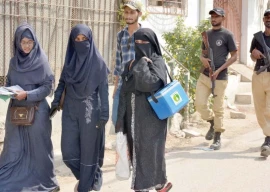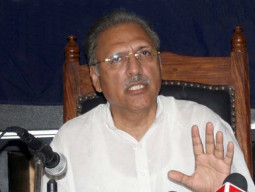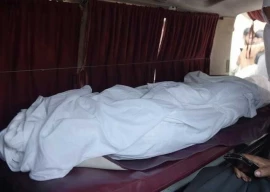
A glance at the work displayed at the gallery is indicative of the fact that the new emerging artists are not only conscious of their surroundings but also have the capacity to view things in a different light. Political commentary in art, although no longer a rare sight at art exhibitions, was the highlight of more than two artists.

One such political allegory was a clock installation by Saba Javed. While the hands depicting the minutes and hours lay still, the numbers on the clock were designed to look like boots, moving in different directions. The boots, a characteristic feature of uniformed personnel, acted as a harsh reminder of how the armed forces remain a part of Pakistan's existence. Similarly, in another set of portraits, one could make out silhouettes of Altaf Hussain, Nawaz Sharif and Imran Khan in the background, as red paint signifying blood and miniature drawings of lotas surrounded it.
Read: Paintings exhibition: Artist portrays human behaviour through postures
Curator Noman Siddiqui, who is also a sculptor and painter by profession, was of the opinion that the young, fresh graduates seemed to have developed a talent for the use of technique and medium. "A writer expresses thoughts through his writings, while for an artist his expression comes through painting," he said. "It's all very different and impactful."
The use of coins as a form of social imagery has been a repetitive diction of artists for a while now. This was seen at the show as a form of nostalgia, such as 50 paisa coins that are no longer in use being utilised by the artists. On the other hand, another coin was a testament to mockery as the inscribed 'Islamia Jamhooria Pakistan' on the coin was coupled with a boy, raising a small plate for food.
Read: Art exhibition: We who were stranded in dark alleys
On the same note of representation of social phenomenon, Samra Roohi of the University of Karachi mastered the technique of lenticular printing on currency notes. By putting a deceptive set of glasses and earmuffs on Quaid-i-Azam's face on the Rs5,000 note, Roohi portrayed the collective idiocy of the Pakistani nation captured in titles such as, 'Na Dekho', 'Na Suno' and 'Na Bolo.' "We, as a Pakistani community, are people who love to indulge in charades and not do anything about it," explained Roohi to The Express Tribune. "Quaid for me has always been a symbol of unity of Pakistanis. So, when I use Quaid's face, I tend to represent the people of Pakistan," she said.

The use of a variety of techniques and mediums created an overwhelming effect for the onlookers. One installation that stood out for its distinctiveness was Hasmain Ali's. Ali made use of electrical circuits and resistors, what he terms as computer parts to revive his childhood memories of when he used to watch movies with giant ants as characters. Though this was not the original thought behind Ali's work, the installation appeared like a bird's eye view from high up the sky, where houses appear like small blocks and people as mere beetles. "I tend to link up my ideas and material. The choice of material has to be synchronous with the idea," he said.
Published in The Express Tribune, July 31st, 2015.

















COMMENTS
Comments are moderated and generally will be posted if they are on-topic and not abusive.
For more information, please see our Comments FAQ